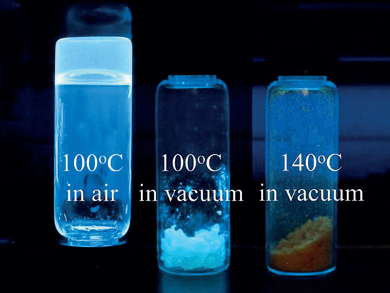Soft fluorescent materials have potential in labeling, bioimaging, and display and lighting applications. However, they often require complicated synthetic procedures. In addition, they can have high production costs and their synthesis often needs toxic or dangerous chemicals, which hampers their usage on an industrial scale.
Hang‐Xing Wang, Hubei University, Wuhan, China, Hao‐Li Zhang, Lanzhou University, China, and colleagues have prepared a fluorescent material by combining citric acid and cysteine. A 1:1 ratio of citric acid and cysteine, dissolved in water and then heated at 70 °C for 30 hours to remove the solvent, gave a fluorescent gel-like product with a quantum yield of almost 90 %.
The researchers analyzed the material using nuclear magnetic resonance (NMR) spectroscopy, X-ray photoelectron spectroscopy (XPS), and electrospray ionization mass spectrometry (ESI-MS), as well as elemental analysis. The team proposes that the reactants are converted to a nonaromatic fluorescent molecule with a ring-fused dihydrothiazolo 2-pyridone scaffold, namely 5-oxo-2,3-dihydro-5H-(1,3)thiazolo(3,2-a)pyridine-3,7-dicarboxylic acid (TPA). The effect of temperature and pH were tested and the team found the gel to be stable under moderate conditions.
With a very mild synthesis from cheap starting materials, this method, which can be employed on a multi-gram scale, shows promise for easily obtainable fluorescent soft materials.
- Facile Preparation of Bright-Fluorescent Soft Materials from Small Organic Molecules,
Hang-Xing Wang, Ze Yang, Zhong-Guo Liu, Jia-Yun Wan, Juan Xiao, Hao-Li Zhang,
Chem. Eur. J. 2016.
DOI: 10.1002/chem.201600448




![Synthesis of [c2]Daisy Chains via Mechanochemistry](https://www.chemistryviews.org/wp-content/uploads/2025/04/202504_RotaxanesWithSolidStateMechanochemistry-125x94.png)